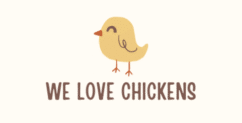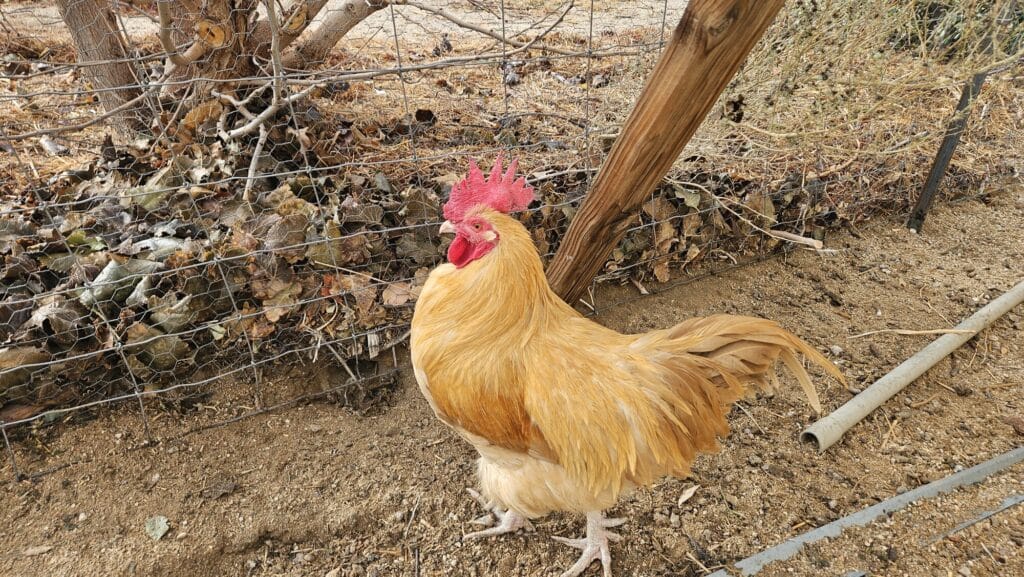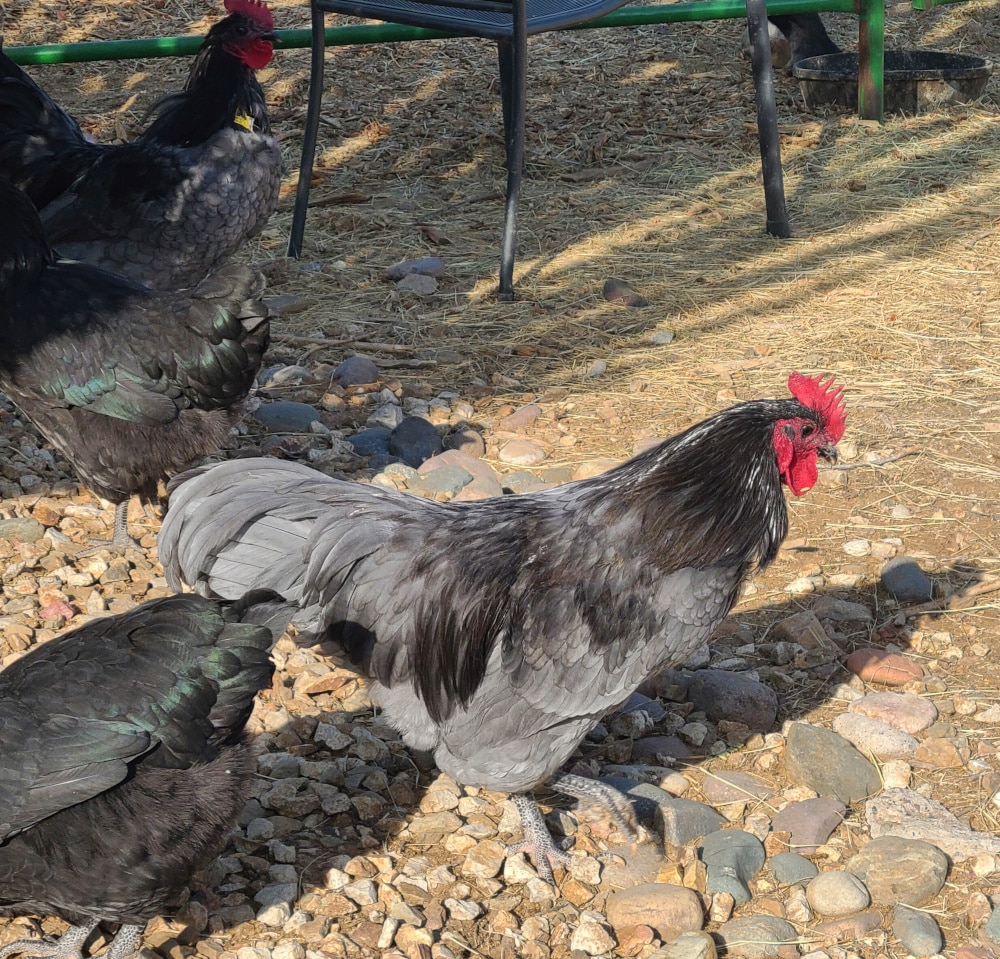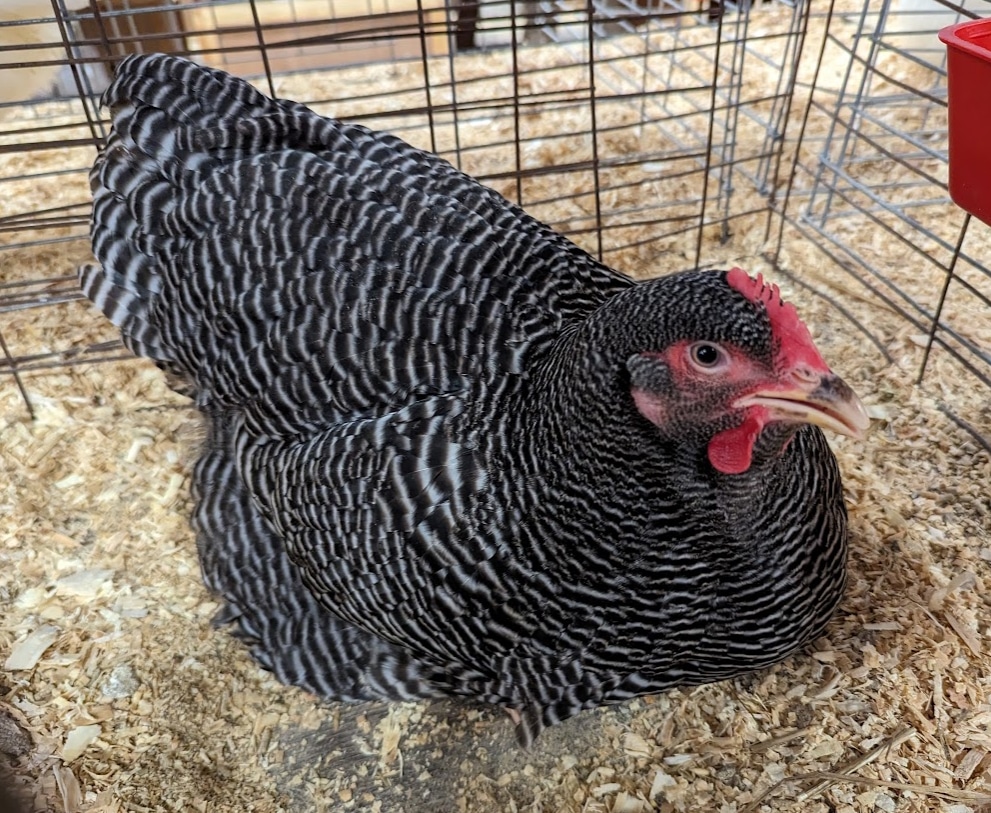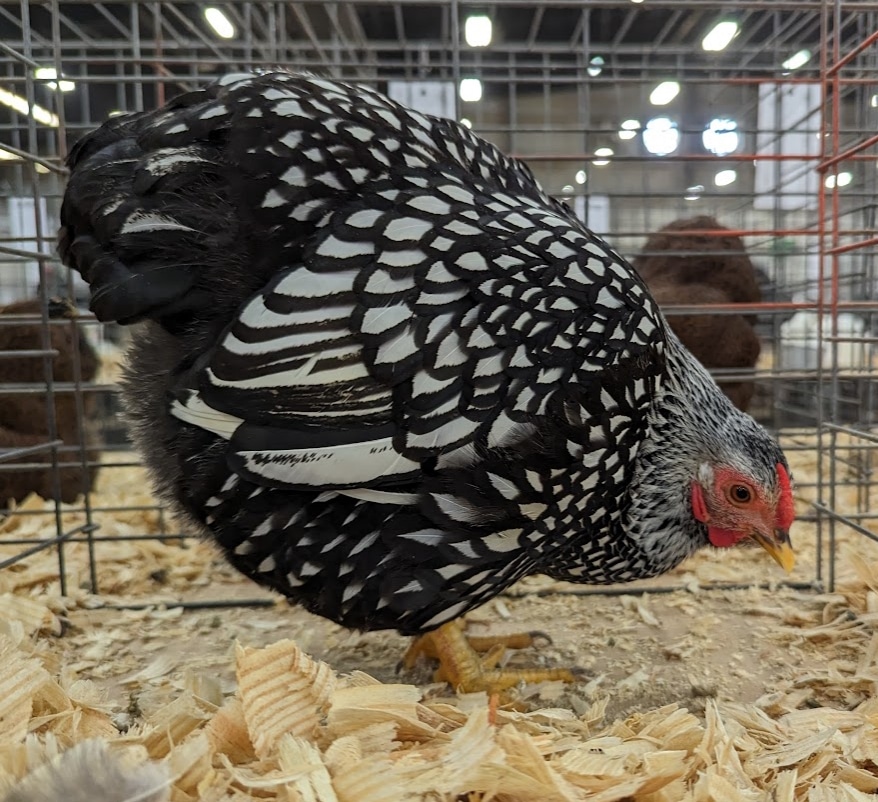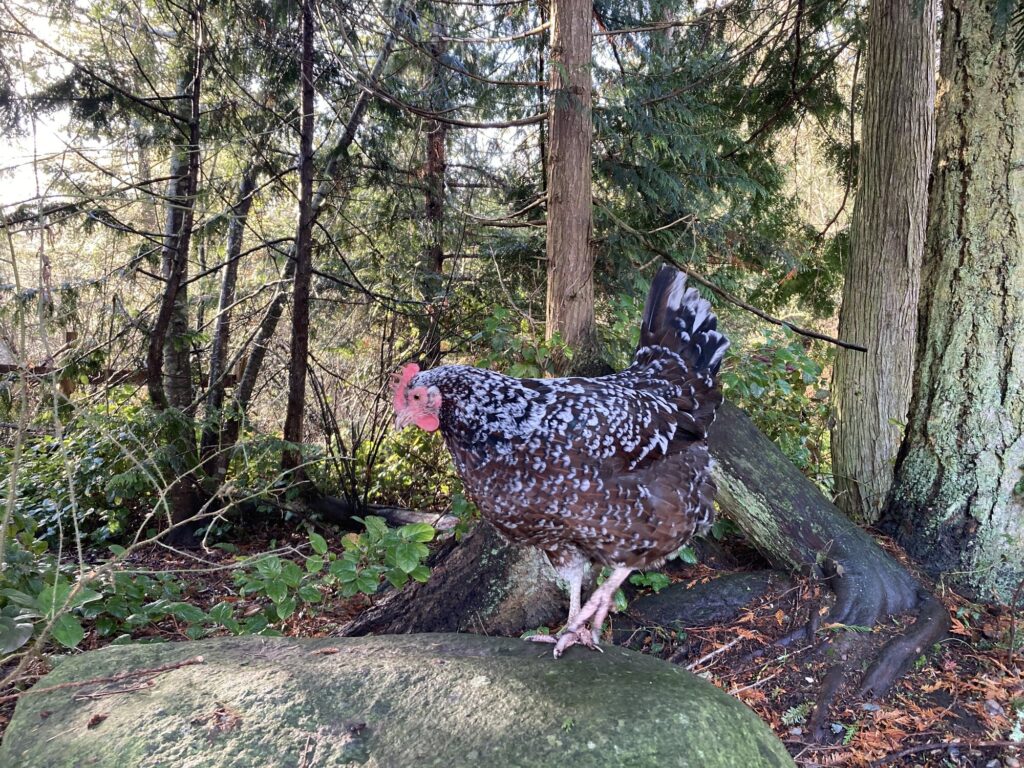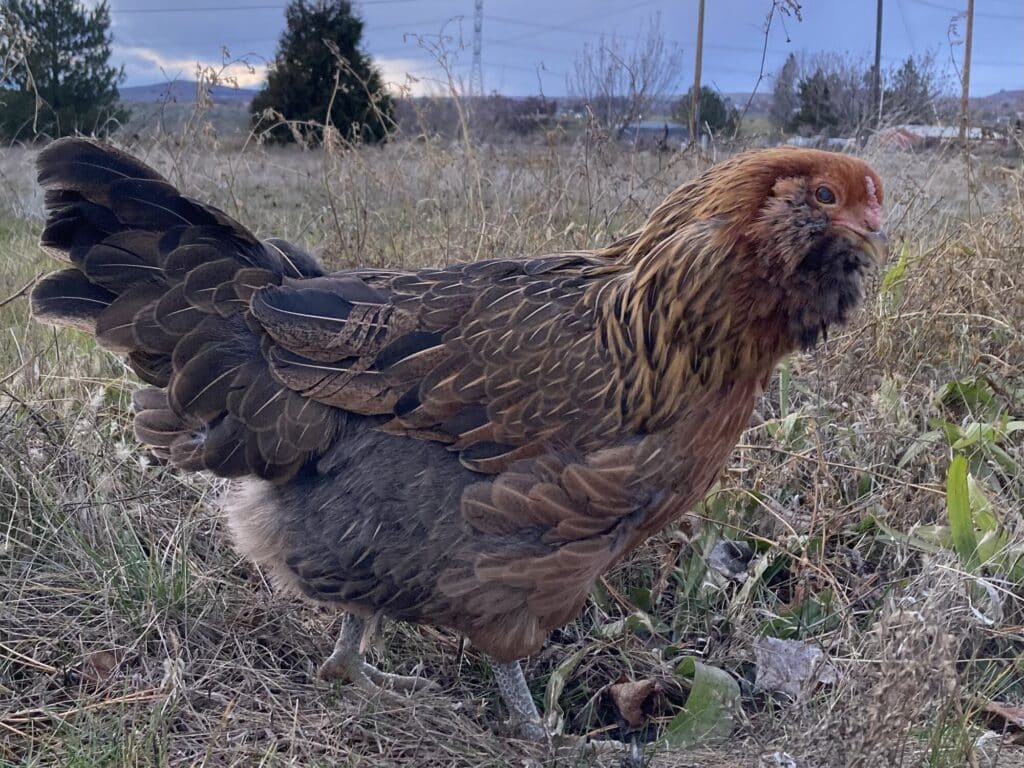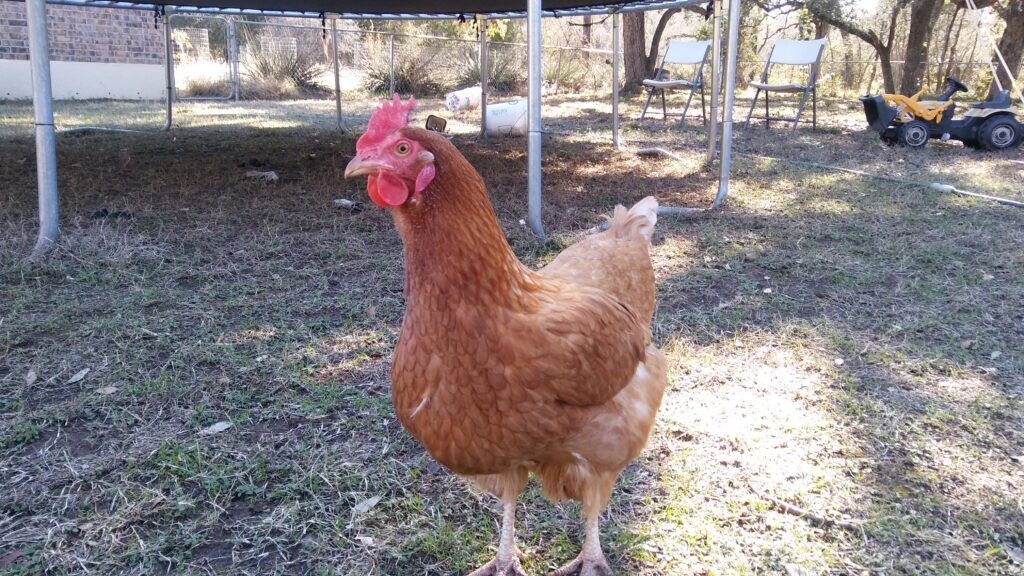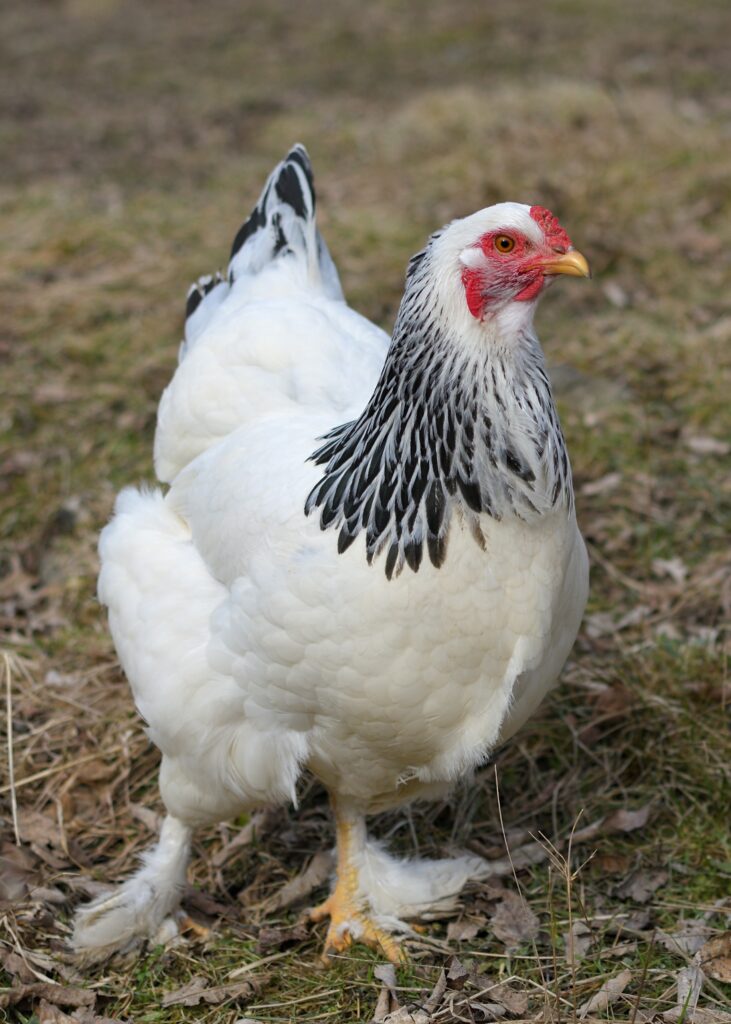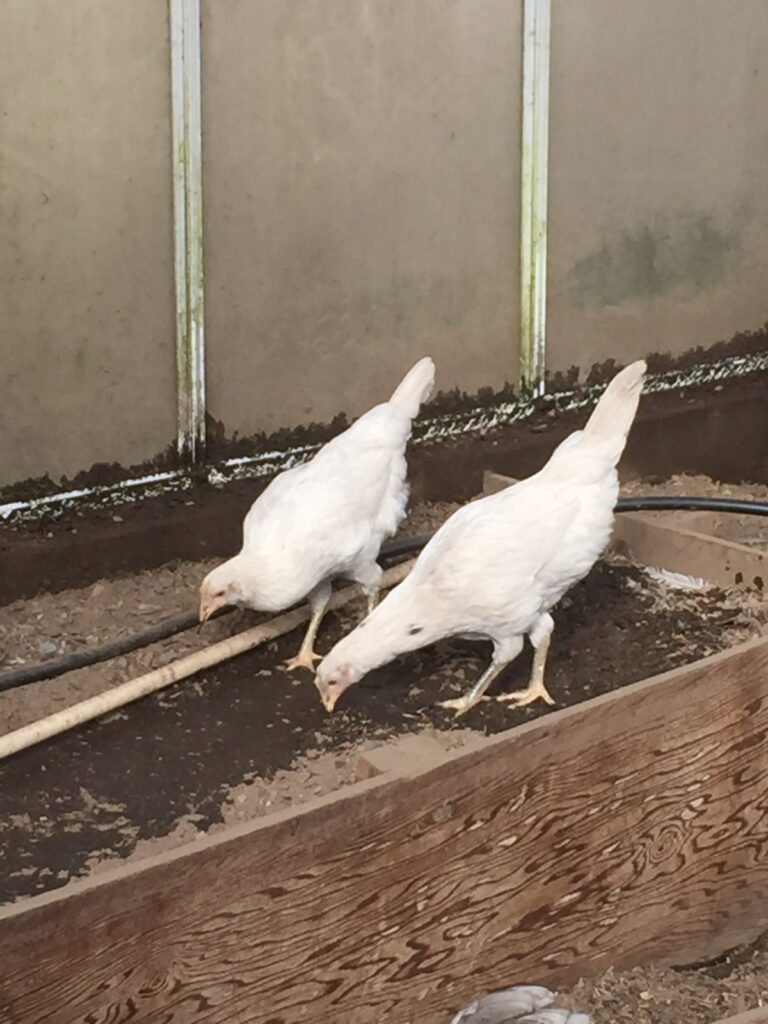If you’ve been thinking about raising chickens but don’t know where to start, picking the right breeds is one of the smartest first moves you can make. The truth is, not all chickens are alike — and some are much better suited for beginners than others.
You want breeds that are calm, friendly, reliable layers, and adaptable to your climate. And if you’ve got kids or want a peaceful backyard flock, temperament matters just as much as egg count.
This guide isn’t just a “top 10” list pulled from random sources. It’s built on real-life feedback from backyard keepers, trusted poultry resources, and over a decade of experience raising flocks in different conditions.
If you’re just getting started with your flock and want a full walkthrough from setup to care, check out our Beginner’s Guide to Raising Chickens.
1. Buff Orpington
If you ask ten backyard chicken owners what their favorite breed is, at least a few will say, “Oh, I just love my Orpingtons.”
Buff Orpingtons are big, soft, golden-colored birds that are often called the “golden retrievers” of the chicken world — and not just because of their color. They’re extremely gentle, love human interaction, and are one of the most beginner-friendly breeds you can get.
Temperament
Orpingtons are calm and docile. They rarely bully other birds, and they’re known for being great around kids. Many will follow you around the yard or hop up next to you for a treat.
Egg Production
Around 180–250 large brown eggs per year. Not the most prolific layers, but very steady — and they often lay through winter when other breeds slow down.
Hardiness
Cold-hardy thanks to their fluffy feathers and large body mass. They handle winter better than heat, so you’ll want to give them shade and cool water in hotter climates.
Care Tips
Orpingtons do have a tendency to go broody. If you don’t want chicks, you’ll need to break them of the habit when it kicks in — but if you do want a broody hen to raise eggs, Orpingtons make fantastic mothers.
Orpingtons are a great choice for anyone who wants their first flock to be as low-drama and people-friendly as possible.
| Trait | Details |
|---|---|
| Temperament | Exceptionally gentle, friendly, and docile |
| Egg Production | 180–250 large brown eggs/year |
| Hardiness | Cold-hardy; tolerates heat with shade |
| Best For | Families, new chicken keepers, pet-like chickens |
| Watch Out For | Often go broody — great for chicks, but reduces egg laying while broody |
2. Australorp
Australorps are the quiet overachievers of the chicken world. They’re soft-feathered, black-bodied birds that don’t make a fuss — but consistently lay more eggs than almost any other breed.
Originally developed in Australia from the Orpington, Australorps were bred for one thing: performance. And they’ve lived up to it. One hen even set a world record by laying 364 eggs in 365 days.
Temperament
Calm, steady, and sweet. They aren’t clingy, but they’ll hang around while you work and won’t mind being handled. Many backyard keepers say their Australorps are some of the easiest chickens they’ve owned.
Egg Production
Expect 250–300 large brown eggs per year. These hens are reliable producers, even without artificial lighting, and often lay well through winter.
Hardiness
Very cold-hardy and decently heat-tolerant. Their black feathers absorb heat, so provide extra shade and water in hot climates. In the cold, they thrive — just watch for frostbite on their single combs.
Care Tips
Australorps don’t pick fights and usually stay in the middle of the pecking order. They adapt well to confinement or free-ranging, and they aren’t likely to hop fences or stir up drama in the coop.
If you’re looking for a breed that’s productive, peaceful, and almost maintenance-free, Australorps are a rock-solid choice — especially if you want a bird that lays through the seasons without making a scene.
| Trait | Details |
|---|---|
| Temperament | Calm, gentle, non-aggressive |
| Egg Production | 250–300 large brown eggs/year |
| Hardiness | Cold-hardy; tolerates heat with shade and cool water |
| Best For | Consistent egg production, low-maintenance flocks |
| Watch Out For | May need comb protection in freezing weather (single comb breed) |
3. Plymouth Rock (Barred Rock)
If you want a calm, steady hen that lays well and fits in almost any backyard setup, Plymouth Rocks are a strong pick — especially the Barred Rock variety, which has beautiful black-and-white striped feathers and a long history as one of America’s most dependable breeds.
They’re often described as the “classic backyard chicken,” and for good reason: they’re friendly, adaptable, and productive without being high-maintenance.
Temperament
Confident but not aggressive. Most Plymouth Rocks are friendly, good with kids, and enjoy human interaction. They aren’t lap chickens like Orpingtons, but they’re calm and curious — a great all-around personality for mixed flocks.
Egg Production
200–280 medium-to-large brown eggs per year. They’re steady layers and often continue producing during colder months when other breeds slow down.
Hardiness
Well-adapted to both hot and cold climates. They do especially well in northern areas if the coop is dry and ventilated. In hot weather, like most heavier breeds, they need shade and water but generally cope well.
Care Tips
Plymouth Rocks are not flighty or hard to contain. They stay close when free-ranging and tend to get along with other birds. They usually sit in the middle of the pecking order — assertive enough not to be bullied, but not usually the troublemaker.
If you’re starting your first flock and want a reliable, hardy chicken that checks nearly every box, Barred Rocks are hard to beat.
| Trait | Details |
|---|---|
| Temperament | Friendly, confident, and steady |
| Egg Production | 200–280 brown eggs/year |
| Hardiness | Adapts well to heat and cold; strong all-season bird |
| Best For | First flocks, mixed breed setups, consistent year-round layers |
| Watch Out For | Can be a bit dominant with timid breeds if space is tight |
4. Rhode Island Red
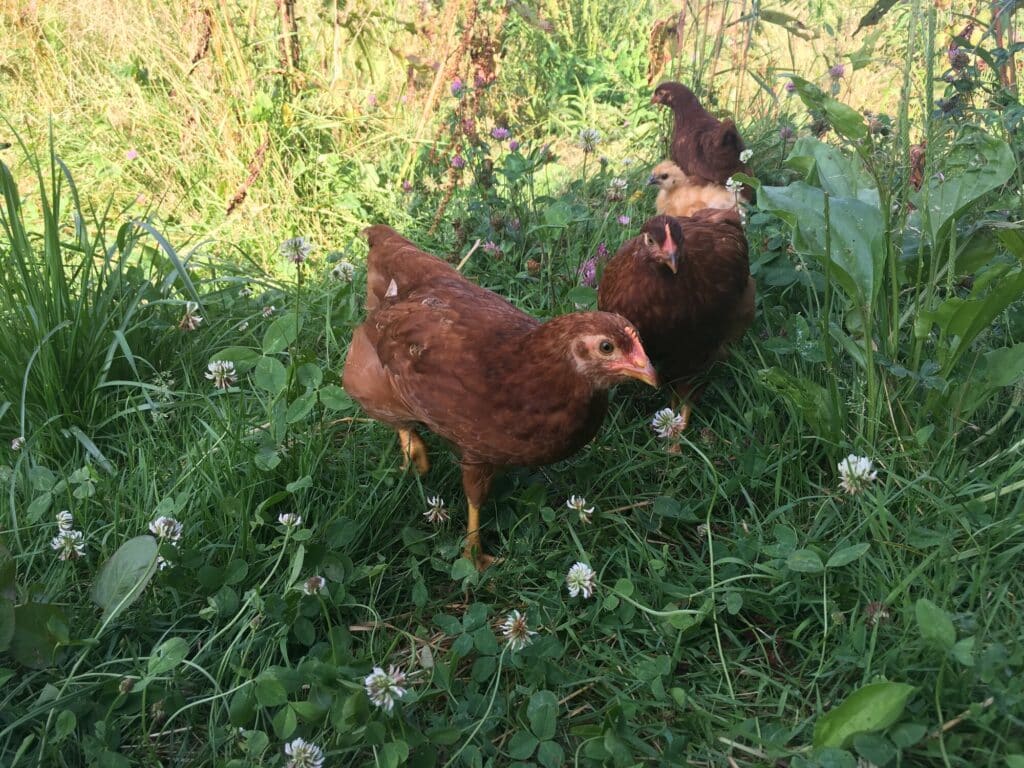
Rhode Island Reds are one of the most iconic American chicken breeds — and for good reason. They’re hardy, efficient, and just a little bit bold. If you’re looking for reliable egg production with minimal fuss, these birds have earned their reputation as backyard staples.
They were originally bred for utility, and it shows. Hatchery strains are especially good for beginners because they’re easy to care for and adapt to just about any climate.
Temperament
Generally friendly but more assertive than ultra-docile breeds. RIR hens are smart, curious, and confident. They usually get along in mixed flocks, but they’ll stand their ground. Great with people — though maybe not as cuddly as an Orpington.
Egg Production
One of the best layers you can get. A good hen will give you 200–300 large brown eggs per year. Many start laying earlier than other breeds, too — often around 18–20 weeks.
Hardiness
Very cold-hardy and heat-tolerant. They’re tough birds that don’t get sick easily and do well in a range of climates. Their single combs can be prone to frostbite in freezing temperatures, so keep an eye on that in winter.
Care Tips
Rhode Island Reds are independent and efficient. They don’t need much encouragement to forage and do their thing. Just make sure they’re not bullying more timid birds in tight quarters — otherwise, they’re low-maintenance, high-output hens.
RIRs are perfect for anyone who wants a productive, durable chicken with a touch of personality.
| Trait | Details |
|---|---|
| Temperament | Bold, smart, and friendly — but a bit dominant |
| Egg Production | 200–300 large brown eggs/year |
| Hardiness | Excellent in both heat and cold; very resilient |
| Best For | Egg-focused keepers, hardy flocks, productive homesteads |
| Watch Out For | Can boss around gentler breeds; watch pecking order in small spaces |
5. Wyandotte
Wyandottes are one of the most beautiful beginner-friendly breeds out there — especially the Silver Laced variety, with crisp black-and-white feather patterns that look almost painted on.
But they’re more than just pretty birds. Wyandottes are cold-hardy, steady layers, and independent enough to do well in almost any backyard setup.
Temperament
Generally calm and friendly, though some can be a little bossy in smaller flocks. They’re not lap chickens, but they aren’t flighty either. Think of them as composed — they do their thing and don’t bother anyone unless they’re being crowded.
Egg Production
Around 200 medium brown eggs per year. Not the heaviest layers, but consistent and reliable. Many lay well through winter, which makes them a good year-round breed in colder areas.
Hardiness
Excellent in the cold. Wyandottes have dense plumage and a small rose comb, which helps prevent frostbite. They can handle heat, but they need plenty of shade and airflow during the summer.
Care Tips
They do best when they have enough space — that helps prevent them from becoming dominant with more timid breeds. They’re good foragers, quiet, and tend to stay close when allowed to free range.
If you want a bird that’s tough, productive, and adds visual interest to your flock, Wyandottes are a fantastic choice.
| Trait | Details |
|---|---|
| Temperament | Calm and confident; occasionally dominant in tight flocks |
| Egg Production | ~200 medium brown eggs/year |
| Hardiness | Excellent cold tolerance; good heat tolerance with shade |
| Best For | Cold climates, beautiful flocks, balanced backyard setups |
| Watch Out For | May become bossy in tight spaces or with very docile breeds |
6. Sussex (Speckled Sussex)
The Sussex is an old English breed known for being curious, friendly, and surprisingly good at egg production. The Speckled Sussex, with its mahogany body and white speckles, is especially popular with backyard chicken keepers who want both personality and looks.
These hens tend to be interactive and alert — not in a nervous way, but more like a dog following you around the yard.
Temperament
Exceptionally friendly and curious. Sussex hens often approach people, follow you during chores, and quickly learn where treats come from. They’re great with kids and make the flock feel more social.
Egg Production
200–250 medium to large light-brown eggs per year. They’re steady layers, especially in spring and fall, and often continue laying through the winter months.
Hardiness
Very adaptable. Sussex chickens do well in both cold and warm climates, thanks to their moderate combs and solid body size. They were bred for English weather, so they’re built for change.
Care Tips
Sussex are excellent foragers and low-maintenance overall. They can go broody, especially in spring, which is great if you plan to hatch chicks — but something to keep an eye on if you’re focused on egg production only.
If you want a chicken that acts like a backyard buddy and still pulls its weight in the nest box, the Sussex is hard to beat.
| Trait | Details |
|---|---|
| Temperament | Curious, friendly, often social with people |
| Egg Production | 200–250 light-brown eggs/year |
| Hardiness | Cold- and heat-tolerant; very adaptable |
| Best For | Families, first-timers, mixed flocks |
| Watch Out For | Can go broody in spring; loves to forage (watch garden beds) |
7. Easter Egger
Easter Eggers aren’t a formal breed — they’re a mix of chickens that carry the blue egg gene, often crossed with Ameraucana, Araucana, or other backyard favorites. Because they’re not standardized, you’ll get a lot of variety in feather color, body shape, and even personality.
That’s part of the fun. You might end up with a compact, bearded hen in muted earth tones, or a lanky, brightly feathered bird with an unusual comb. No two Easter Eggers are quite the same.
Temperament
Generally easygoing and friendly, but there’s some variation. One hen might hang back quietly, while another follows you around the yard. They usually fit well into mixed flocks and don’t stir up drama.
Egg Production
Expect about 150–200 eggs per year. Each hen lays one color — most often blue or green, but some produce pinkish or pale cream eggs. The color is a nice bonus, and it adds variety to your egg basket.
Hardiness
Strong all-around. Easter Eggers typically have small pea combs that are less prone to frostbite, making them a good fit for cold climates. Thanks to their mixed background, they also tend to be healthy and adaptable in warm areas too.
Care Tips
They’re low-maintenance and good foragers. Because they’re not bred to a strict standard, you may notice small differences in behavior or body size across your flock. That’s normal — and part of why so many backyard keepers enjoy them.
If you’re looking for a chicken that’s hardy, friendly, and lays eggs in unexpected colors, Easter Eggers are an easy favorite.
| Trait | Details |
|---|---|
| Temperament | Easygoing and friendly; personalities vary slightly |
| Egg Production | 150–200 colorful eggs/year (usually blue or green) |
| Hardiness | Great for both cold and warm climates; small comb = frostbite-resistant |
| Best For | Families, variety lovers, first-time keepers |
| Watch Out For | Inconsistent appearance and personality — expect surprises |
Honorable Mentions
These breeds didn’t make the top seven, but they’re still beginner-friendly in the right situations. Some are egg-laying powerhouses, others are more about personality or looks — and a few come with trade-offs that are worth understanding before you commit.
ISA Brown / Sex-Link Hybrids
These hybrid chickens are bred specifically for performance. ISA Browns, Red Stars, and other “sex-links” are consistent, friendly, and impressively productive. Many hatcheries recommend them for beginners because they start laying early and are extremely docile.
They’ll give you around 280–320 large brown eggs per year, often without needing supplemental light in winter. Most are calm, people-friendly, and fit in well with mixed flocks.
The trade-off? They typically slow down significantly after 2–3 years, and some people report health issues as they age due to their high-output genetics. Still, they’re a fantastic choice if you want maximum eggs and a gentle bird.
Brahma
Brahmas are large, quiet chickens with feathered legs and a calm, almost regal presence. They don’t mind cold weather at all — in fact, they thrive in it. Their thick feathering and body mass make them one of the best cold-hardy breeds.
They usually lay around 150–200 medium brown eggs per year. Not the heaviest layers, but reliable through winter when others might stop.
Because they’re so heavy, they do best in coops with strong roosts and wide nesting boxes. Despite their size, they’re among the gentlest chickens you can own — a solid pick for cold climates or families.
Make sure your setup meets the minimum space requirements for big-bodied birds.
Cochin
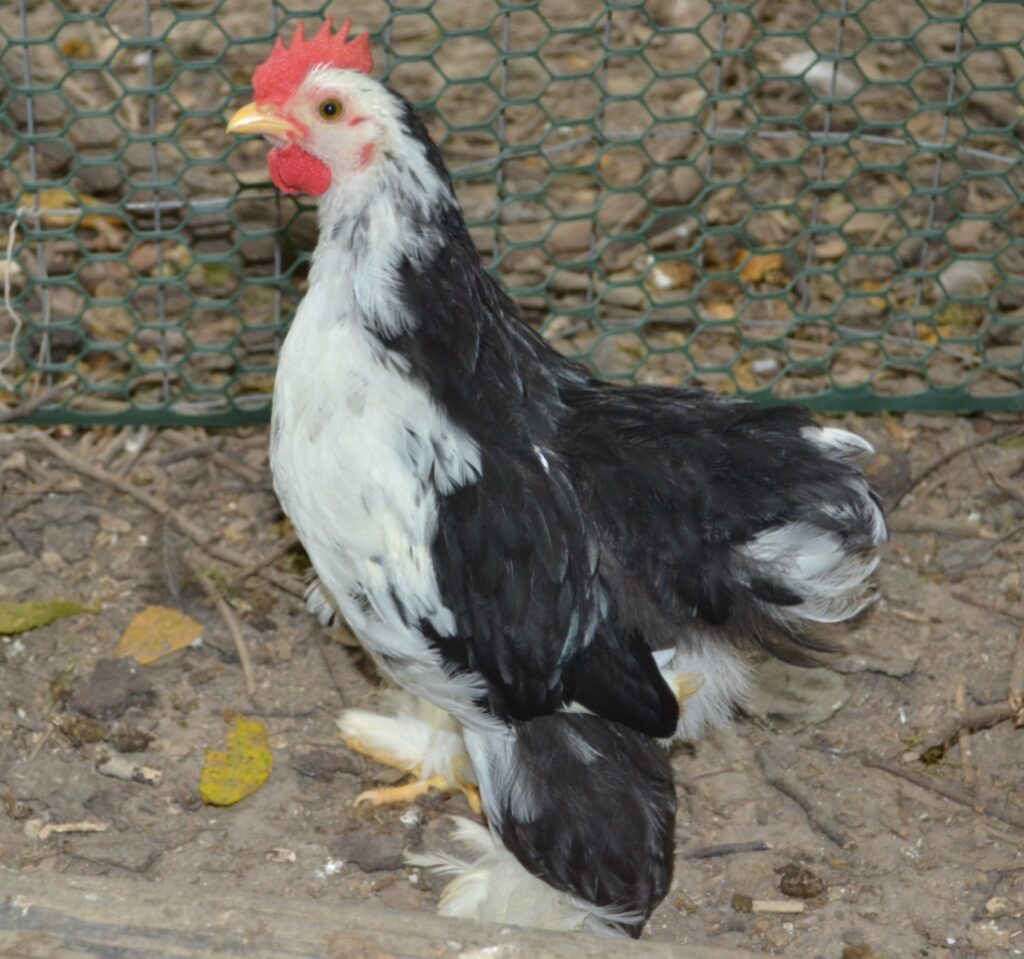
Cochins are another big, fluffy breed — famous for their calm, cuddly nature. They have thick feathering all the way down their legs and toes, which gives them a unique look (and a need for dry bedding).
They aren’t egg machines — expect about 150 small eggs per year — but their personalities make up for it. These chickens are great for kids, very tolerant of handling, and rarely cause conflict in the flock.
They do tend to go broody often, so if you’re not planning to hatch chicks, you’ll want to monitor that. For people who want a calm, ornamental pet-like chicken, Cochins are hard to beat.
Silkie
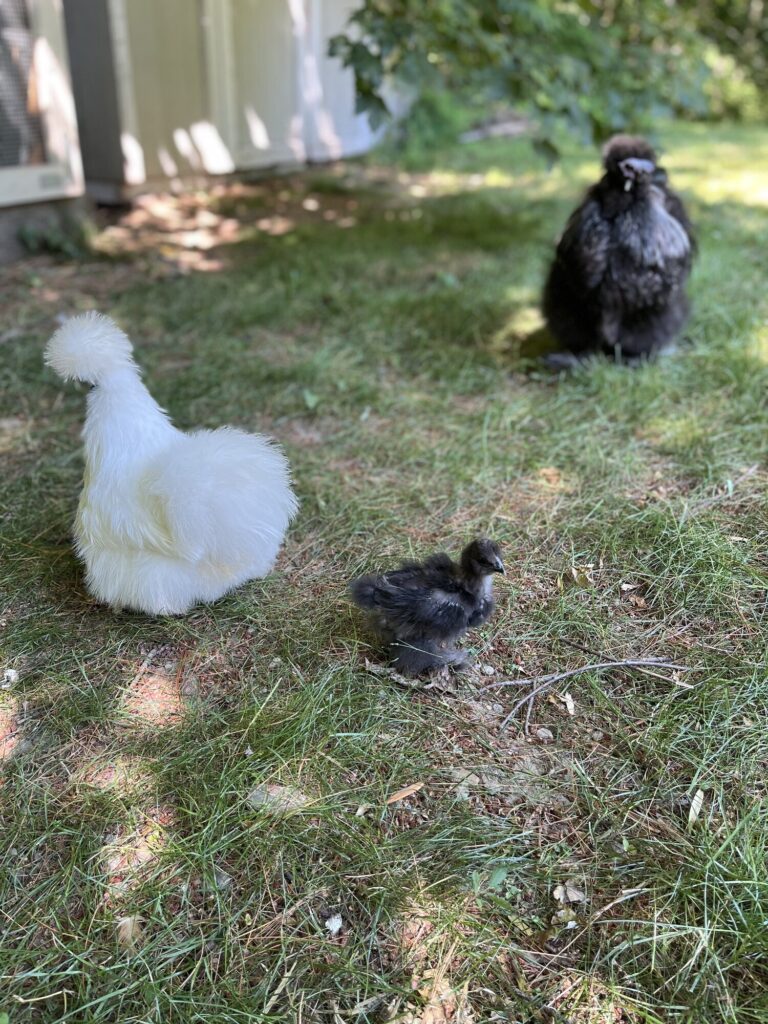
Silkies are small, unusual-looking chickens with soft, hair-like feathers, black skin, and feathered feet. But it’s their temperament that really stands out — they’re sweet, quiet, and incredibly gentle.
They’re not great layers (100–120 tiny eggs per year), but they go broody constantly and are often used to hatch eggs from other breeds.
Because their feathers aren’t waterproof, they need a dry, draft-free coop and protection in wet or cold weather. They’re perfect for people who want a friendly pet chicken or a natural broody hen.
Leghorn
Leghorns are lean, athletic birds bred for efficiency. They lay large white eggs — around 280–320 per year — and don’t eat as much feed as heavier breeds.
They’re great if you’re focused on egg numbers, but they’re not cuddly or calm. Leghorns are often flighty, alert, and quick to flee if startled. They also tend to be louder than average.
Still, if you want a low-feed, high-output bird and don’t mind one that keeps to itself, Leghorns are worth considering.
Conclusion
Choosing the right breeds isn’t just about egg numbers — it’s about matching chickens to your goals, your climate, and the kind of experience you want to have.
If you’re looking for calm, family-friendly birds that are easy to care for, breeds like the Buff Orpington, Australorp, and Sussex are excellent choices. If you want strong egg production, Rhode Island Reds or ISA Browns will give you plenty to work with. And if you’re after a colorful egg basket, Easter Eggers are a fun place to start.
For most beginners, a mixed flock is the way to go. It gives you a chance to learn what you like, see how different personalities interact, and enjoy a more interesting backyard setup.
No matter which breeds you choose, the key is giving them a clean, safe place to live, good food, and a little daily attention. Chickens are surprisingly rewarding — not just for the eggs, but for the routine, the rhythm, and the connection they bring to your home.
Let your first flock teach you. You’ll be surprised how much you learn.
Sources
- Backyard Chickens Forum — real experiences from chicken keepers across the world
- University of Minnesota Extension — expert poultry care and housing guidelines
- Fresh Eggs Daily — practical advice from an experienced backyard chicken keeper
- PetMD: Chicken Coops — veterinary-backed tips for safe, functional housing
- RSPCA Australia — welfare-focused poultry care resources
